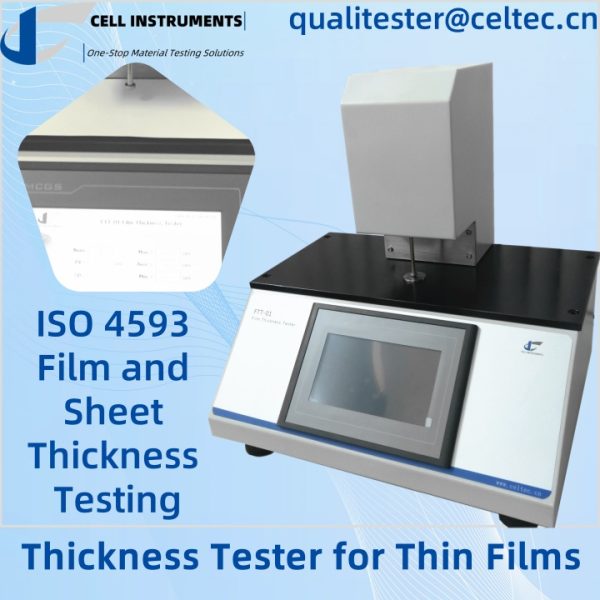How to Measure Film Thickness for Paper Packaging: An In-Depth Look at ISO 4593
Accurately Thickness tester for thin film is essential to maintaining the quality and performance of packaging materials. Whether in the food, pharmaceutical or electronics industries, consistent thickness ensures that packaging materials meet regulatory standards and function reliably. This article will explore the importance of film thickness testing, the methods used, and how to choose the right instrument for your needs.
Understanding Film Thickness Testing
The measurement of thin films, especially those used for packaging, requires precision and consistency. Thickness tester for thin film, foils, and papers to ensure that they meet specific requirements.
Film Thickness Measurement Methods
There are many methods for measuring film thickness, each with its own advantages. The most widely recognized standards include ASTM D374, ASTM D1777, ISO 3034, ISO 534, and ISO 4593. These standards provide guidance on procedures for accurate and repeatable measurements, ensuring consistency between different laboratories and applications.
ASTM D374 and ASTM D1777
These methods are generally used to determine the thickness of plastics and flexible materials, focusing on the use of micrometers or other precision instruments.
ISO 4593
Specific to plastic films and sheets, provides guidance for measurements using the displacement method. This method is particularly important when discussing thickness tester for thin film.
Why Accurate Thickness Measurement is Important
In the packaging world, the thickness of a material directly affects the strength, flexibility, and barrier properties of a product. For example, in the food industry, incorrect thickness can result in a package that fails to protect the contents, leading to spoilage or contamination.
Similarly, in the pharmaceutical industry, packaging materials must meet strict thickness standards to ensure product safety and meet regulatory requirements. Inconsistent thickness can lead to product failures, recalls, and even legal issues.
Key Features of Thickness Tester for Thin Film
When choosing a thickness tester for thin film, consider the following key features:
- High precision and accuracy: The tester should provide reliable measurements with minimal deviations, which is critical for quality control.
- User-friendly interface: Instruments with intuitive software and easy-to-navigate interfaces (such as those controlled by a PLC and operated via a human-machine interface touchscreen) are suitable for both novice and experienced users.
- Versatility: The tester can measure a wide range of materials, including films, foils, paper, and paperboard, increasing the tester’s suitability for use in a variety of industries.
- Customizable setup: The instrument setup can be customized to specific testing requirements, ensuring that unique needs are met without sacrificing accuracy or reliability.
For example, the thickness tester for thin film from Cell Instruments has these features and more. Designed for precise measurements and ease of use, the instrument is ideal for industries where material thickness is critical.
Best Practices for Film Thickness Testing in the Lab
Using the right techniques and equipment is essential to obtaining accurate thickness measurement results. Here are some best practices:
- Calibration: Always calibrate the instrument using a standard block to ensure accuracy.
- Sample preparation: Ensure that samples are clean, wrinkle-free, and measured at the appropriate test temperature.
- Consistent testing conditions: Keep conditions such as ambient temperature and humidity consistent to avoid measurement variations.
By following these practices and using instruments that meet international standards such as ISO 4593, labs can ensure that measurements are accurate and reliable.
Summary: The Importance of Choosing the Right Thickness Tester
Choosing the right packaging film thickness tester is essential to maintaining product quality and meeting regulatory requirements. Cell Instruments benchtop film thickness testers are accurate, versatile, and user-friendly, meeting the stringent requirements of a wide range of industries.
FAQ
Q: What is the importance of film thickness testing in packaging?
A: Accurate thickness measurements ensure that packaging materials meet regulatory standards, maintain product integrity, and operate reliably in a variety of environments.
Q: What standards are commonly used for film thickness testing?
A: Standards such as ASTM D374, ASTM D1777, ISO 3034, ISO 534, and ISO 4593 provide guidance for accurate and repeatable thickness measurements.
Q: How do I choose the right thickness tester for my needs?
A: It depends on features such as high accuracy, ease of use, versatility, and customizable settings to meet specific testing requirements.
Q: What is the best way to measure film thickness in the lab?
A: Ensure proper calibration, sample preparation, and consistent test conditions to obtain accurate measurements.
Q: Why is ISO 4593 important for film thickness testing?
A: ISO 4593 provides a standardized method for thickness measurement of plastic film and sheeting, ensuring consistent, reliable results across laboratories.
Related Products
Benchtop Film
Thickness Tester
Related Article
Film
Thickness Tester for Packaging
Lab
Thickness Tester for Paper
Bench
Thickness Tester for Textile
Thickness
Tester Machine for Textiles

